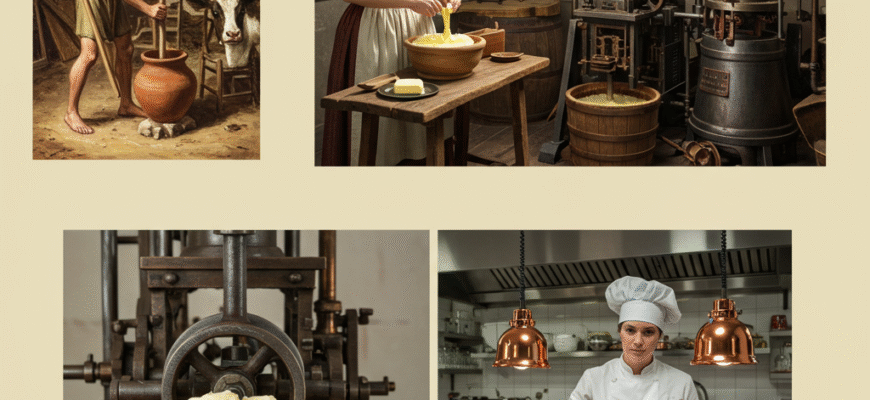Content
Accidental Origins and Ancient Recognition
The story likely begins not in a kitchen, but on the move. Picture early herders, perhaps 8,000 to 10,000 years ago, carrying milk in animal skins or gourds. The constant jostling during travel would have naturally agitated the milk. Fat globules, normally suspended, would collide, break down their protective membranes, and clump together, separating from the watery liquid (buttermilk). This accidental churning yielded the first primitive butter. It wasn’t planned; it was a consequence of preserving and transporting a vital food source. While direct evidence is scarce, clues point to its early existence. Sumerian mosaics from around 2500 BCE depict dairy activities that strongly suggest butter making. Ancient texts, including the Bible, contain references to butter, often associating it with prosperity and abundance. For societies dependent on livestock, this energy-dense fat would have been a valuable resource, especially in colder climates or during periods of food scarcity.Historical records and archaeological findings confirm butter’s presence across various ancient civilizations. From Sumerian art depicting dairy processing to mentions in ancient Indian texts where ghee (clarified butter) held ritual significance, it’s clear butter was valued early on. Its role varied, sometimes as food, other times in religious ceremonies or even as a rudimentary cosmetic or sealant.However, butter’s reception wasn’t universally warm. In the ancient Mediterranean world, olive oil reigned supreme. The Greeks and Romans often viewed butter as a food fit for “barbarians” – the northern tribes like the Celts and Vikings who relied more heavily on animal fats due to their climate. For these northern European cultures, butter was not just sustenance but a symbol of wealth.
From Skin Bags to Specialized Churns
Early butter making was laborious. Methods involved shaking milk in sealed skins, beating it in gourds, or stirring it vigorously in pots with paddles or sticks. These techniques required significant time and effort for relatively small yields. Over centuries, dedicated tools emerged to streamline the process. The plunge churn, essentially a tall, narrow wooden tub with a lid featuring a hole for a dasher (a long stick with a wooden disk or crossbars at the end), became common. Moving the dasher up and down forcefully agitated the cream. Later came the barrel churn, a closed barrel turned by a crank, allowing the cream inside to tumble and churn itself. The paddle churn, often a boxy container with internal paddles turned by a crank, represented another step towards efficiency. These innovations, while simple by today’s standards, transformed butter making from a purely domestic chore into a more scalable activity, paving the way for it to become a traded commodity.Butter Through the Middle Ages and Beyond
During the Middle Ages in Europe, particularly in the north, butter’s culinary importance grew significantly. It became a key ingredient in sauces, a cooking medium, and a simple spread. Its consumption was sometimes tied to religious observances; during Lent, animal fats were often restricted, leading to periods where butter was forbidden for many, though dispensations could sometimes be purchased. The demand led to the development of butter markets and quality controls, albeit rudimentary ones. Butter production remained largely farm-based, with distinct regional variations in flavor and texture emerging based on local cattle breeds, pasture quality, and production methods. The Renaissance and subsequent centuries saw butter solidify its place in European haute cuisine, particularly in France, where techniques for clarifying butter and creating butter-based sauces were refined.Industrialization and the Modern Era
The 19th century brought revolutionary changes. The invention of the centrifugal cream separator in the 1870s allowed for the rapid and efficient separation of cream from milk, a crucial step before churning. This significantly boosted the potential scale of butter production. Shortly thereafter, continuous churns were developed, moving away from batch processes to automated, large-scale production lines. These technological advancements shifted butter making from farms and small dairies to large industrial creameries. This era also saw the invention and rise of margarine, initially developed as a cheaper alternative, sparking “butter wars” and regulations regarding labeling and coloration.Varieties on a Theme
While the basic concept remains simple, butter exists in several forms:- Salted vs. Unsalted: Salt acts as a preservative and enhances flavor. Unsalted butter gives cooks more control over the final seasoning and is often preferred in baking.
- Cultured Butter: Made from cream fermented with bacterial cultures before churning. It has a tangier, more complex flavor profile, reminiscent of traditional European butters.
- Clarified Butter/Ghee: Butter that has been melted and cooked to remove water content and milk solids. It has a higher smoke point, making it ideal for high-heat cooking, and a longer shelf life. Ghee is a staple in South Asian cuisine.
- Whey Butter: Made from the residual fat recovered from whey after cheese making. It can have a slightly different, often cheesier, flavor.
- Compound Butter: Butter mixed with herbs, spices, garlic, or other flavorings (e.g., maître d’hôtel butter). Used as a finishing touch for grilled meats, fish, or vegetables.
The Indispensable Culinary Ingredient
Butter’s enduring appeal lies in its remarkable versatility in the kitchen. It’s far more than just a spread.Flavor Powerhouse
Butter carries fat-soluble flavors beautifully and adds its own distinct richness. Browning butter (beurre noisette) creates nutty, toasted notes that elevate both sweet and savory dishes.Cooking Medium
While its smoke point is lower than many oils, butter is excellent for sautéing vegetables, cooking eggs, or pan-frying delicate items over moderate heat, imparting unparalleled flavor.Baking Magic
In baking, butter is critical:- Leavening: Creaming butter with sugar incorporates air, creating lift and a tender crumb in cakes and cookies.
- Texture: Cold butter pieces create steam pockets when baked, resulting in flaky layers in pastries like croissants and pie crusts.
- Tenderness: Fat coats flour proteins, inhibiting gluten development, which leads to more tender baked goods.
- Richness and Mouthfeel: It contributes significantly to the satisfying texture and richness of baked items.









